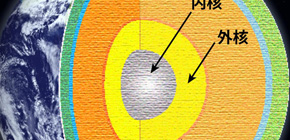
The inner core of the Earth is 700 million years old?
Successful measurement of electrical conductivity of iron under the conditions of the Earth’s inner core
A group of researchers consisting of Lecturer OHTA Kenji and Professor HIROSE Kei at Tokyo Institute of Technology, Professor KUWAYAMA Yasuhiro at Ehime University, Professor SHIMIZU Katsuya at Osaka University, and Principal Researcher OISHI Yasuo at the Japan Synchrotron Radiation Research Institute, using the large synchrotron radiation facility SPring-8, measured the electrical conductivity of iron, the major component of the inner core of the earth, under high-pressure and high-temperature conditions (157 GPa and 4,500 kelvin (absolute temperature)), clarifying that the electrical and thermal conductivities at the inner core of the earth were 3 times higher than conventional expectation.
The earth’s inner core consists of a two-layer structure of a solid inner core and a liquid outer core and is a very high-pressure and high-temperature region. As the heat in the inner core of the earth moves to its surface, the temperature of the inner core drops little by little, and with this, the size of the inner core increases. It is thought that magnetic fields have existed on the earth due to convection in the earth's outer core since about 4.2 billion years ago.
In order to know when the inner core was made and if the existence of the inner core affects earth’s magnetic fields, it is necessary to clarify the electrical conductivity of iron in experiments. However, even on the top layer of the outer core, the pressure and temperature are very high (135 GPa and 4,000 K), leading to technical difficulties in measuring the conductivity of matter under such extreme conditions.
Using a laser-heated diamond-anvil cell in which iron samples could be kept at high temperature and pressure at SPring-8, this joint group succeeded in measuring the electrical conductivity of iron under high temperatures and pressures equivalent to the conditions of the inner core of the earth. As a result, it was found that the electrical conductivity of the inner core was 90 W/m/K, three times higher than conventional expectation, and that the electrical and thermal conductivities at the inner core of the earth were very active.
From conductivity of the inner core, it can be estimated that the year of birth of Earth's inner core was about 700 million years ago. This result gives new knowledge about the mechanism behind the generation and maintenance of magnetic fields of the earth, which are confirmed to be 4 billion years old or older.
Abstract
Earth continuously generates a dipole magnetic field in its convecting liquid outer core by a self-sustained dynamo action. Metallic iron is a dominant component of the outer core, so its electrical and thermal conductivity controls the dynamics and thermal evolution of Earth’s core. However, in spite of extensive research, the transport properties of iron under core conditions are still controversial. Since free electrons are a primary carrier of both electric current and heat, the electron scattering mechanism in iron under high pressure and temperature holds the key to understanding the transport properties of planetary cores. Here we measure the electrical resistivity (the reciprocal of electrical conductivity) of iron at the high temperatures (up to 4,500 kelvin) and pressures (megabars) of Earth’s core in a laser-heated diamond-anvil cell. The value measured for the resistivity of iron is even lower than the value extrapolated from high-pressure, low-temperature data using the Bloch–Grüneisen law, which considers only the electron–phonon scattering. This shows that the iron resistivity is strongly suppressed by the resistivity saturation effect at high temperatures. The low electrical resistivity of iron indicates the high thermal conductivity of Earth’s core, suggesting rapid core cooling and a young inner core less than 0.7 billion years old. Therefore, an abrupt increase in palaeomagnetic field intensity around 1.3 billion years ago11 may not be related to the birth of the inner core.

Figure 1
To learn more about this research, please view the full research report entitled “ Experimental determination of the electrical resistivity of iron at Earth’s core conditions ” at this page of the Nature website.
Related link
